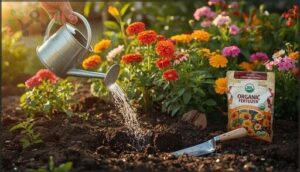This site is supported by our readers. We may earn a commission, at no cost to you, if you purchase through links.
Your garden doesn’t have to surrender when the mercury climbs past 90°F. While many flowers wilt under intense summer sun, a strategic approach to warm season flower care keeps blooms thriving through the hottest months.
The difference between a scorched landscape and a vibrant display often comes down to three factors: choosing varieties that actually tolerate heat, preparing soil that holds moisture without drowning roots, and timing your watering to match what plants need during temperature extremes.
Master these fundamentals, and you’ll discover that summer heat becomes an advantage rather than an obstacle—transforming your garden into a haven that flourishes when others fade.
Table Of Contents
- Key Takeaways
- Choosing Warm Season Flowers
- Preparing Soil for Summer Flower Success
- Watering and Fertilizing Warm Season Flowers
- Protecting Flowers From Heat and Sun
- Essential Maintenance for Healthy Summer Flowers
- Frequently Asked Questions (FAQs)
- What is a warm season annual flower?
- What is a warm season annual?
- What is a cool-season annual flower?
- Can annual plants handle heat?
- Do heat tolerant annuals grow in hot weather?
- Do hardy annuals rebloom in winter?
- How to keep flowers alive in extreme heat?
- Do you cut back flowers for winter?
- What is the 3 year rule in gardening?
- What is the most heat tolerant flower?
- Conclusion
Key Takeaways
- Choose heat-tolerant perennials like coreopsis and daylilies that maintain 80% bloom coverage above 90°F while cutting water needs by 30%, and pair them with drought-resistant annuals like angelonia and lantana that retain over 75% flower coverage in extreme temperatures.
- Prepare soil with proper drainage using 20% perlite in sandy conditions and maintain a 4:1 nitrogen-to-phosphorus ratio, then apply 2–3 inches of mulch to reduce evaporation by 50% and lower soil temperatures by up to 10°C.
- Water deeply every 4 days during high heat in early morning or late evening to boost absorption by 30%, and use phosphorus-rich fertilizers (10-30-20 ratio) in early spring and after initial bloom to increase flower production by 20%.
- Install 30–40% shade cloth during peak heat hours (10 am to 4 pm) to drop temperatures by 3–7°C and reduce watering frequency by 15–30%, while deadheading spent blooms weekly to redirect energy and boost productivity by 27%.
Choosing Warm Season Flowers
Picking the right flowers for hot weather means choosing plants that won’t wilt when temperatures climb. Not all flowers handle heat equally well, and knowing which ones thrive in summer sun saves you time and frustration.
Let’s look at the best options for creating a garden that stays vibrant even when the thermometer soars.
Best Heat-Tolerant Perennials
Perennials are the backbone of any hot-weather garden because they return year after year, asking little in return. When temperatures climb past 90°F, these plants don’t just survive—they thrive. Here are five heat-resistant plants that deliver consistent summer blooming flowers:
- Coreopsis varieties maintain 80% bloom coverage even during consecutive high-heat days
- Daylily benefits include 60-day flowering spans in temperatures exceeding 85°F
- Liatris care is minimal; it thrives in sandy soils with 8+ hours of direct sun
- Iris bloom persists on just 1 inch of weekly water once established
- Sedum persistence shines with 92–98% foliage integrity through weeks without rain
These drought-resistant plants reduce landscape water needs by up to 30% while supporting pollinators throughout summer. Consider adding drought-tolerant Sedum to your garden for its easy-care properties.
Top Annuals for Hot Climates
Growing annuals in summer means choosing heat-tolerant plant selection that blooms reliably when it matters most.
Angelonia care is straightforward—it maintains over 75% flower coverage above 90°F. Lantana varieties survive 35°C heat with 92% color retention. Zinnia colors intensify under sun exposure, while petunia hybrids hold 60% of blooms at 35°C. Gomphrena growth excels with 90% bloom viability through sustained heat.
These plants exemplify how heat-tolerant plants thrive in challenging conditions.
Selecting Drought-Resistant Varieties
Beyond heat tolerance alone, drought-resistant plants save you water and time. Native species with deep roots cut irrigation needs by up to 70%, while xeriscaping strategies reduce water use 30-50% in hot climates.
Drought-resistant plants with deep roots slash irrigation needs by up to 70% while saving time and money
Heat-tolerant flowers like lavender hyssop and blackfoot daisy thrive in heat zones with less than an inch of weekly rainfall. Soil adaptation matters—sandy and loamy soils promote drought-tolerant garden design success.
You’ll slash maintenance costs by 40% while supporting local ecosystems.
Flowers That Attract Pollinators
Smart drought-resistant choices naturally set the stage for attracting pollinators to your garden. Warm-season flowers with vivid floral signals—think zinnia, marigold, and catmint—draw bees and hummingbirds in droves. Bloom succession keeps summer blooms buzzing with life, boosting habitat diversity and pollinator conservation. Why settle for silence when you can fill your beds with pollinator-friendly color?
- Zinnia ‘Zahara Sunburst’ for bee attraction
- Catmint ‘Walker’s Low’ aids bloom succession
- Marigold ‘Alumia Vanilla Cream’ maximizes summer blooms
- Diverse plantings foster habitat diversity and pollinator conservation
Preparing Soil for Summer Flower Success
Your flowers can’t thrive in hot weather if the soil isn’t ready to support them. The right soil structure helps roots stay cool, holds enough moisture without drowning plants, and provides nutrients when heat stress hits hardest.
Let’s look at three essential soil preparation strategies that set your summer blooms up for success.
Optimizing Drainage in Sandy or Rocky Soils
Sandy and rocky conditions naturally move water quickly, but you can improve soil preparation further. Incorporate 20% perlite to cut irrigation needs by half, or add 10% compost to boost retention by 35%. Raised beds with a 10–15 cm gravel base reduce standing water by 85%. Mixed organic and gravel mulches stabilize moisture while maintaining excellent, well-draining, rocky, sandy soil conditions.
| Amendment Type | Application Rate | Drainage Benefit |
|---|---|---|
| Perlite | 20% by volume | 50% less irrigation |
| Compost | 10% by volume | 35% better retention |
| Gravel base layer | 10–15 cm depth | 85% less pooling |
| Organic + gravel mulch | 5–7 cm surface | 30–40% evaporation cut |
Amending Soil for Nutrient Needs
You’ll see your flowers reach their full potential when nitrogen and phosphorus sit at a 4:1 ratio in your soil. Test your soil pH—aim for 6.0–7.2 for best nutrient uptake and stronger blooms.
Before planting, mix 2.5 lbs of slow-release fertilizer per 50 sq ft, then reapply mid-season. Each 1% increase in organic matter releases 10–20 lbs of nitrogen annually.
Container and Raised Bed Preparation
For thriving container gardening this summer, you’ll need proper drainage holes to prevent root rot within days. Mix a professional potting blend featuring peat moss, perlite, and compost for prime aeration methods and water retention.
When preparing garden soil for raised beds:
- Fill with well-draining soil at least 12 inches deep
- Add sterilized loam to prevent compaction prevention issues
- Choose taller beds (18–24 inches) for better temperature regulation
- Refresh container soil every 1–2 years before planting
Watering and Fertilizing Warm Season Flowers
Watering and fertilizing are the backbone of keeping your warm season flowers alive when temperatures soar. The right schedule and technique depend on your climate, soil type, and the specific needs of your plants.
Let’s break down how to water smartly and choose fertilizers that fuel strong, continuous blooms.
Scheduling Irrigation for High Temperatures
When temperatures climb above 90°F, your flowers need water regularly—every 4 days—to survive drought conditions and high humidity. Water deeply in the early morning or late evening to boost absorption by 30% and reach 6–12 inches into the soil.
During heatwaves, increase irrigation frequency by 25–50%. Weather-based scheduling and mulch irrigation reduction can cut water needs by 25–40%.
Watering Techniques for Different Soil Types
Your soil type determines how you water. Clay soil holds moisture longer and needs deep, infrequent watering to avoid runoff. Sandy soil drains fast and requires more frequent irrigation with organic amendments. Loam irrigation balances retention and drainage, while peat amendment boosts water-holding capacity in any soil conditions.
- Apply 1 inch of water per week in loam or well-drained soil, adjusting for rainfall
- Water clay soil less often but deeply to saturate root zones
- Irrigate sandy soil every 3–4 days to maintain moist soil
- Add compost to improve moisture retention by 15–30% across all soil types
- Use drip systems for precise delivery and reduced evaporation in hot weather
Fertilizer Choices for Strong Blooms
Strong blooms depend on the right fertilizer at the right time. Choose phosphorus-rich NPK ratios like 10-30-20 to boost flower production by 20% without excess nitrogen driving leaf growth. Apply in early spring and after initial bloom for up to 18% more flowers.
Organic vs. synthetic formulas both work if nutrients match, extending bloom duration 5-8 days with consistent plant care and proper gardening tips for your flowering plants.
Protecting Flowers From Heat and Sun
Even the toughest heat-loving flowers face challenges when temperatures soar above 90°F or when record-breaking heatwaves roll through your region. Without proper protection, your blooms can suffer visible damage within days, from scorched petals to stressed root systems.
Here are three practical strategies to shield your flowers from extreme heat and intense sun exposure.
Using Mulch to Retain Moisture
During peak summer heat, applying a 2 to 3-inch layer of mulch can cut soil evaporation by up to 50% compared to bare beds. Straw and shredded bark are excellent mulch material types that retain moisture without compacting, while also lowering soil temperature spikes by up to 10°C.
Pull mulch back 2 to 3 inches from flower stems to prevent rot and disease.
Providing Shade During Extreme Heat
Mulch helps, but when heat tops 90°F, afternoon shade becomes your best defense. Installing shade cloth with 30–40% density during the hottest hours (10 am to 4 pm) drops temperatures by 3–7°C. Artificial shading benefits include reduced watering frequency by 15–30% and lower pest problems. Shade timing strategies matter—protecting plants from heat during flowering prevents blossom drop.
- Reflective shade cloth outperforms black varieties by up to 1.8°C
- Movable shade structures let flowers acclimate to varying light intensity
- Shaded flowers retain better petal color throughout summer
- Water savings average 20% in nurseries using shade protection
Preventing Petal and Leaf Sunburn
Shade helps, but direct sun still damages petals and leaves when temperatures climb. Watering techniques matter—early watering and misting techniques during peak heat reduce visible burn by 12–15%. Sunscreen application using horticultural oils cuts UV penetration up to 45%. Mulch benefits extend beyond moisture to lowering leaf temps by 5°F.
Protecting plants from heat works best when you combine strategies: tolerant varieties, reflective mulches, and plant care tips that prevent tissue damage before it starts.
Essential Maintenance for Healthy Summer Flowers
Your flowers can handle the heat, but they still need a little attention to stay strong through summer. Regular maintenance keeps blooms coming and helps you catch problems before they spiral out of control.
Here’s what you need to focus on to keep your warm-season garden in top shape.
Deadheading and Pruning Techniques
Deadheading timing matters more than you might think during hot weather. Remove spent blooms weekly on fast-growing annuals to redirect energy from seed production to fresh flowers.
Cut back to a lateral bud using clean pruners, or pinch smaller blooms with your fingers. This simple pruning method boosts flower productivity by up to 27% while improving air circulation and plant health throughout summer.
Monitoring for Stress and Disease
Visual stress signs appear early if you check your flowers regularly. Elevated leaf temperature, wilting, and leaf scorch signal trouble before serious damage occurs. Spotting these symptoms catches 90% of disease and drought issues in time.
Watch for these common problems:
- Powdery mildew – develops when humidity exceeds 70% for extended periods
- Root rot – strikes when soil stays waterlogged beyond 48 hours
- Garden pests – multiply rapidly during heat waves above 32°C
Environmental triggers like extreme heat and poor watering techniques create ideal conditions for disease. Regular monitoring prevents economic impacts from plant loss and reduces the need for costly replanting. Disease prevention through careful observation protects your summer blooms and saves money throughout the growing season.
Supporting Tall or Top-Heavy Flowers
Installing braces when your flowers reach 6–12 inches tall prevents root disturbance and maximizes stability.
Staking techniques like single stakes or grow-through grids reduce stem breakage by up to 60% during storms. Material efficiency matters—metal stakes last five seasons, while soft ties prevent injury.
Proper installation timing and flower adaptation help dahlias, sunflowers, and zinnias maintain upright growth through demanding summer conditions.
Frequently Asked Questions (FAQs)
What is a warm season annual flower?
A warm season annual flower completes its entire lifecycle—germination, blooming, and seed production—within one growing season.
These heat-tolerant flowers thrive when soil temperatures reach 65°F to 75°F, usually during late spring through summer.
What is a warm season annual?
A warm season annual completes its entire lifecycle—germination, growth, blooming season, and seed production—within one growing season.
These heat-tolerant flowers thrive between 80°F and 90°F, delivering vibrant flower colors all summer long.
What is a cool-season annual flower?
Cool-season annuals—like Pansies, Snapdragons, and Petunias—complete their life cycle in one year, thriving in early spring or fall. They tolerate frost but struggle when temperatures consistently exceed 80–85°F.
Can annual plants handle heat?
Many annuals handle heat well, though survivorship rates vary widely. Cultivar heat resilience and soil moisture effects determine success more than temperature alone.
Heat-tolerant flowers like lantana show remarkable photosynthetic efficiency even during extreme conditions.
Do heat tolerant annuals grow in hot weather?
Yes, heat-tolerant annuals absolutely grow and flourish in fiery, formidable conditions. Zinnias, lantana, and moss rose maintain consistent bloom temperature range and seasonal bloom duration—often thriving continuously beyond 30°C with proper drought-resistant growth support and watering techniques.
Do hardy annuals rebloom in winter?
Hardy annuals rarely rebloom during winter itself. Winter rebloom rates stay below 15% in mild climates.
Most survive cold temperatures down to 21°F, then resume vigorous blooms in early spring as temperatures rise.
How to keep flowers alive in extreme heat?
Mulch benefits include reducing soil heat and retaining moisture. Shade options protect blooms during midday peaks.
Watering timing matters—water early morning.
Stem trimming at 45 degrees improves uptake, helping heat-tolerant flowers withstand extreme conditions.
Do you cut back flowers for winter?
You’ll cut back most perennials after the first frost, trimming stems to 1–2 inches above soil. Pruning removes diseased foliage and controls pests, but wait until spring for woody plants to avoid winter damage.
What is the 3 year rule in gardening?
The 3 year rule describes how perennials generally develop: they sleep during year one as root development takes priority, creep in year two with moderate growth, then leap in year three with peak blooms and mature size.
What is the most heat tolerant flower?
Portulaca, also known as moss rose, ranks among the most heat-resistant plants, thriving in drought conditions with minimal watering needs.
This warm season flower excels in hardiness zones with intense summer heat and direct sun exposure.
Conclusion
Ironically, the season most gardeners fear becomes your garden’s finest hour when you apply proper warm season flower care. Heat-tolerant varieties, moisture-retentive soil, and strategic watering transform brutal temperatures into your advantage.
Those three fundamentals separate gardens that merely survive from those that genuinely thrive. Your neighbors will wonder how your blooms stay vibrant while theirs fade—the answer lies in working with summer’s intensity rather than against it. Heat doesn’t have to mean defeat.
- https://www.everbloomfields.com/post/growing-cut-flowers-in-warm-hot-climates
- https://enchantedgardensrichmond.com/watering-guidelines/
- https://www.rhs.org.uk/science/articles/extreme-heat-survey
- https://ginghamgardens.com/using-mulch-in-your-flower-garden/
- https://www.frontiersin.org/journals/plant-science/articles/10.3389/fpls.2022.1012859/full










